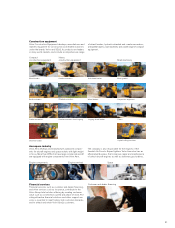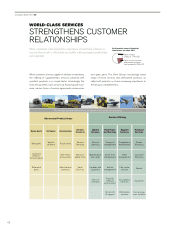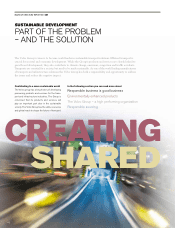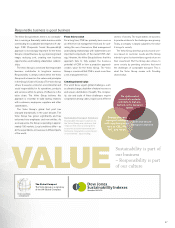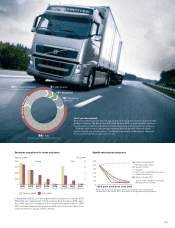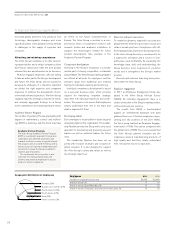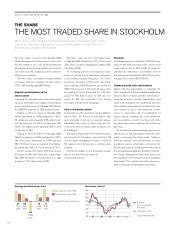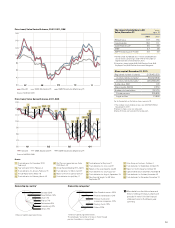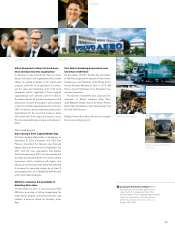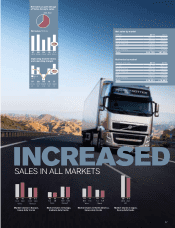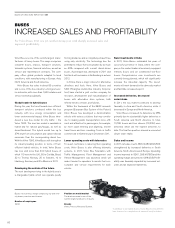Volvo 2011 Annual Report Download - page 54
Download and view the complete annual report
Please find page 54 of the 2011 Volvo annual report below. You can navigate through the pages in the report by either clicking on the pages listed below, or by using the keyword search tool below to find specific information within the annual report.
BOARD OF DIRECTORS’ REPORT 2011
Key figures 2011 2010
Number of employees at year-end 98,162 90,409
Share of women, % 17 16
Share of women, Board Members, % 13 12
Share of women, Presidents and other senior executives, % 17 15
Increased global presence, new products, new
technology, demographic changes and more
rapid fluctuations in the global economy will lead
to challenges in the supply of expertise and
resources.
Attracting and retaining competence
The Volvo Group’s ambition is to offer interest-
ing opportunities and a unique company culture
that help us attract and retain the best people,
whoever they are and wherever we do business.
Without engaged employees, who are willing
to take an active part in the Group’s development
and future, the Volvo Group will not succeed in
pursuing its strategies. It is therefore important
we attract the right expertise and competent
engineers to continue the development of envi-
ronmentally enhanced products. The Volvo Group
regularly maps the strategic competence needs,
and annually aggregate findings on a Group
level to identify the most important future needs.
Academic Partner Program
The number of people in Europe graduating with
degrees in mathematics, science and technol-
ogy (MST) is declining, and this trend may have
an effect on the future competitiveness of
Europe. The Volvo Group is involved in a com-
prehensive series of cooperative ventures with
research bodies and academic institutions to
advance the technologies needed for future
product development. One example is the
Academic Partner Program.
Competence development
Investing in the Group’s employees is a funda-
mental part of staying competitive, sustainable
and profit able. The Volvo Group’s training programs
are offered at all levels for employees, and the
activities range from traditional and e-based
training to individual coaching and mentoring.
Individual competence development is based
on a personal business plan, which provides
support for translating corporate strategic
objectives into individual objectives and contri-
bution. The purpose is to ensure that employees
clearly understand their role in the team and
what is expected of them.
Developing talents
Every manager is responsible for assessing and
developing talent in the organization. The Leader-
ship Pipeline provides the Group with a structured
approach to developing and preparing present
leaders as well as potential leaders for future
roles.
The Leadership Pipeline has been set up
jointly with research institutes and is based on
global research. It is also designed to support
the Volvo Group’s culture and values as well as
the strategic objectives.
Geographic distribution of employees
Sweden 25%
Europe, excl. Sweden 31%
North America 16%
South America 5%
Asia 20%
Other countries 3%
Diversity enhances innovation
To create the dynamics required to succeed at a
global level the Volvo Group needs to recruit and
retain a broad spectrum of employees with dif-
ferent backgrounds, experience and perspectives.
In the Volvo Group diversity is considered to be
a catalyst for innovation and a source of com-
petitiveness and profitability. By expanding the
knowledge base, skills and understanding, the
Group becomes more responsive to customer
needs and it strengthens the Group’s market
position.
Diversity and inclusion have long been priori-
tized within the Volvo Group.
Employee engagement
In 2011, an Employee Engagement Index was
added to the Volvo Group Attitude Survey
(VGAS). By including engagement there is a
clearer connection to the Group’s wanted position,
culture and business success.
The results from VGAS is benchmarked
against an international database with data
gathered from over 14 million employees, repre-
senting over 80 countries. In the 2011 VGAS,
the Volvo group reached an Employee Engage-
ment Index of 76%. This can be compared with
the global norm of 68%. The survey reveals that
the Volvo Group’s general strengths are the
employees’ pride at manufacturing products of
high quality and that they clearly understand
their role and the business objectives.
A high-performing organization
Academic Partner Program
The Volvo Group Academic Partner Program
(APP) is a systematic approach for long-term
cooperation with selected universities and
research institutes in areas of special interest.
The program aims to provide the Group with a
holistic picture of important collaborative part-
ners and to increase the Group’s visibility to
students and researchers.
Our involvement with universities is also
important for creating relationships with
students and potential employees to secure
access to future competence.
50



